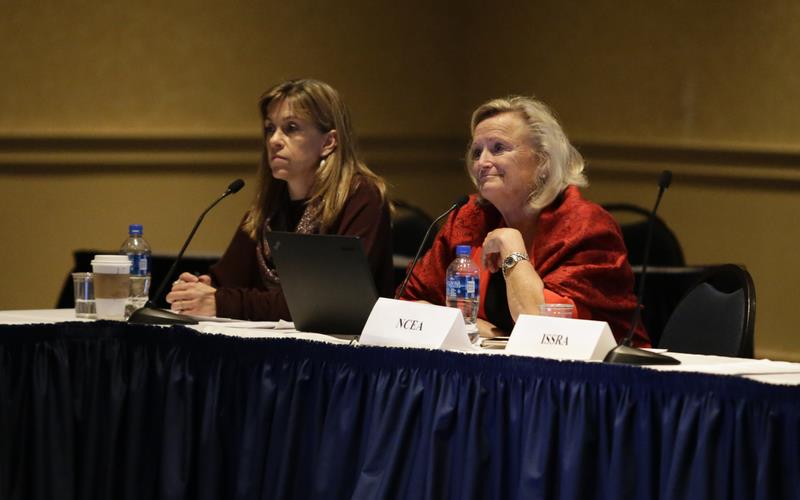Leaders from collegiate and scholastic organizations gathered Friday at US Equestrian’s Annual Meeting to share ideas, discuss marketing and promotional opportunities, and learn more about US Equestrian’s many resources for educational partners.
“We wanted to get together to discuss how we can promote participation in equestrian sport, how we can assist the scholastic and collegiate groups in raising awareness of what they do, what their formats are, what the opportunities are,” US Equestrian CEO Bill Moroney said as he opened the Collegiate/Scholastic Equestrian Summit. “We also want to look at the opportunities we have to cross-promote each other and grow the sport of equestrian. The goal of US Equestrian is to get people on a horse and get them involved in equestrian sport, because we have a lot of breeds and disciplines people can go into, and, ultimately, if we get them on a horse, they’re going to participate in someone’s program. It just continues to grow what we do.”

(Photo: Taylor Pence)
The Collegiate/Scholastic Summit included representatives from the Intercollegiate Horse Shows Association, National Collegiate Equestrian Association, Interscholastic Equestrian Association, and United States Eventing Association Intercollegiate Eventing.
Moroney solicited opinions from the group about a potential US Equestrian affiliate level, an Educational Affiliate Partnership, for collegiate and scholastic groups that could strengthen the mutually beneficial bond between the collegiate/scholastic world and US Equestrian.
“We’re all trying to introduce people to the opportunities of horse sports and get people riding, and then try to keep them in equestrian sport,” Moroney said. “We want them to have an affinity for organized equestrian sport, so that when they advance out of these programs and are looking for what’s next, the next steps have been made clear to them along the way and you have the connections to come back to.”
There is also potential for incorporating handicapped equestrians—something the Intercollegiate Horse Shows Association already does, as described to the group by the IHSA’s Peter Cashman—which would provide a pipeline for those athletes to also enter US Equestrian’s para-equestrian sports.
Early discussion about US Equestrian’s Lettering Program—which is set to receive enhanced promotion—raised the suggestion that US Equestrian also incorporate recognition for a student’s breed/discipline affiliation. Collegiate/scholastic leaders expressed interest, too, in how the Stable Finder that has been proposed for the US Equestrian website might help attract people to equestrian sport. And there was unanimous agreement that the scholastic and collegiate groups are key both to introducing young people to equestrian sport and to keeping them involved in the crucial 18- to 24-year-old age range, when US Equestrian, many affiliates, and the broader equine industry often lose young equestrians’ participation in horse sports.
One way to keep those equestrians involved, scholastic and collegiate leaders noted, is to partner with college and university equine science programs to promote the many career opportunities in equine fields.
Moroney agreed. “There are so many opportunities out there, and I think we have to get in front of these students at an early age,” he said.
One career option ripe for promotion: equestrian sport governance, as a licensed official. Several summit participants pointed to a dwindling number of licensed officials, which prompted the suggestion from United States Eventing Association CEO Rob Burk that US Equestrian work to develop a curriculum proposal for collegiate equine studies programs.
The conversation also covered challenges collegiate and scholastic organizations face: the need horse donations, maintaining older horses, securing more participation from barns and educational institutions, and providing access to equestrian training for students at all levels, not just those who have been riding for years.
In addition, the summit featured a review of current resources US Equestrian offers to its affiliated collegiate/scholastic organizations. In addition to the Lettering Program, these include spreading the groups’ stories and program information to a broader national audience through Equestrian Weekly and US Equestrian magazine; Learning Center videos on such subjects as maintaining the older horse in competition and how to donate a horse to a collegiate program; College Search; insurance resources; coaching education, and more.
Want more articles like this delivered to your inbox every week? Sign up here to receive our free Equestrian Weekly newsletter.
This article is original content produced by US Equestrian and may only be shared via social media. It is not to be repurposed or used on any other website aside from USequestrian.org.


